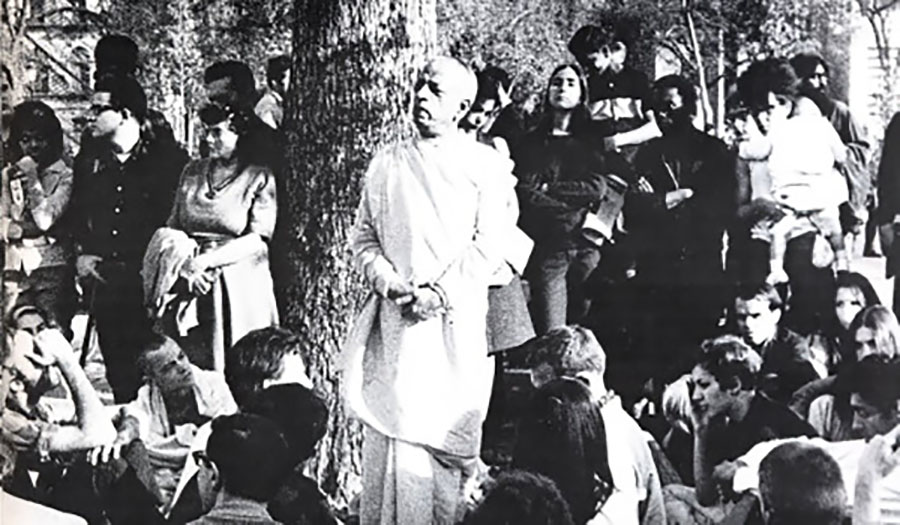ISKCON 50 Meditations: October 31, 2016
By Satsvarupa dasa Goswami | Oct 31, 2016

The Glories of Lunchtime at 26 Second Avenue
One of the nicest times with the Swami was when we all came together to eat lunch. At the very beginning, a group of regulars would attend the Swami’s lecture, but as soon as the kirtana was over, each person would go back to his apartment and his separate life. But once we ate together every day, it created an intimacy.
Let me remember it again: I come in just a few minutes after one o’clock, straight from the welfare office. I’m not exactly late, but lunch is already underway, I’m a little anxious and hungry; I want to be sure that I get a plate. “Satsvarupa, come on!” They make a space for me and I sit down near the wall. The rug has been rolled back and we sit on the bare parquet floors. There is one row of eaters along the three walls, and then another half-circle of people in the center of the room. In the center of everything, sitting just to the right of the low table with the Panca-tattva picture, is the Swami. Kirtanananda comes in with capatis and says, “Everybody has to take at least two helpings. Right, Swamiji?” “Yes,” Swamiji says, “eat more.” Swamiji himself is eating. He mixes the different preparations together with his right hand—pours the dal onto the rice and then mixes the rice with the dal with his fingers, then pushes the sabji into the rice and takes the capati and pushes everything together. He eats quickly while everything is still warm and he continues to mix it. It’s almost like he’s tasting with his hand as well as with his mouth and eyes. The Swami’s eating was another art which was new and fascinating to us. We all eat with our right hands, just like the Swamiji. It’s a joyful but serious business, chewing meditatively and relishing.
Hayagriva says, “This is very succulent!” Others praise the food. Swamiji says, “I can teach you many preparations. I’ve only taught a few.” How foolish the nondevotees are for not knowing how to eat in Krishna consciousness! Aromas of food come from the kitchen, the smell of hot rice as it goes on everyone’s plate, and the vegetables and capatis and the butter in a combined good dinner aroma. Eating first and talking second. But there is talk also. The Swami is usually quiet, especially at the peak of the eating, but sometimes Hayagriva is talking about American poetry, Walt Whitman or Emily Dickenson, and Rayarama has something to say about that. After a while, the Swami looks up and asks, “Raphael, when will you fix the lock?” And, “Stryadhisa, how is your mother?” An old acquaintance of the Swami from uptown, Mr. Nelson, has come, and Swami is glad to see him. Some who come to see him are a bit eccentric and some aren’t serious devotees, but Swamiji is always cordial to them. He invites everyone to eat and eat more.
I like sitting on the floor cross-legged in front of my dish. I’m hungry and I like the tastes, and I like it when it’s hot. I never liked hot rice before. Rice was something my mother would be embarrassed to give you. It was for poor people or Chinese. But wow! This was good—rice and vegetables, and you touch it with your hand. Kirtanananda’s capatis are like pancakes. The Swami calls them rotis. I ask, “How do you make the capatis come out like this? Kirtanananda laughs and says, “Swamiji showed me.” Everyone is eating away or passing their plates in for seconds and thirds. We’re all sitting on the same level as the Swami and looking over to him. The Swami leans slightly over his plate and there he is—the heart of the new Krishna conscious life which you’ve adopted. His clothes are humble, whatever khadi he brought from India, with inexpensive additions that we bought him, T-shirts or jerseys from the Orchard Street markets. Although he is the guru, there is no elevated seat. He is barefoot and eating the same prasadam as everyone. When he finishes, Swamiji gets up and walks across the room and washes his hands in the bathroom, then goes to his own room. We begin to finish up also. This is a good time for sneaking in to see Swamiji to ask a question or get some more typing.















